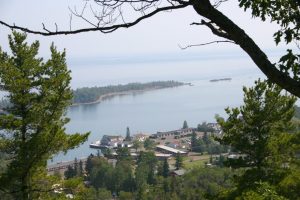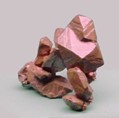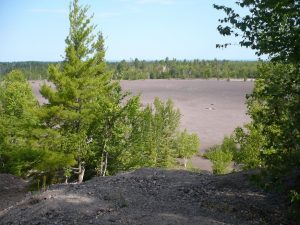
In this article, frequent contributor, David Oates steps across “The Pond” to bring us a compelling mining story with a very strong Cornish connection.
In 2001 and 2007 I visited the Keweenaw Peninsula of Upper Michigan with the Holman-Climax Male Voice Choir. The second visit was for the gathering of the Cornish Cousins of North America at which I gave a presentation on Cornish dialect to those of Cornish descent from across North America and was a memorable experience. I was also fortunate to visit the sites of long abandoned mines developed by the Cornish miners including a visit to the preserved Methodist Church in the ghost town that was Central Mine. The experience in that building was one that none present will forget as long as they live and was an emotional and spiritual life experience. It will be remembered in Part 2 of this celebration of the Cornish in the Keweenaw area of the Upper Peninsula of Michigan.
Between 1861 and 1901 it is estimated that 20% of the male population of Cornwall migrated overseas every decade because of unemployment at home and the need for their expertise in other lands. Largely as a result of this it is estimated that there are 6 million people, worldwide, of Cornish descent. They took their culture with them and it is still found in great measure today in the places where they settled. Indeed, in many areas of the Cornish diaspora they embrace that culture with more enthusiasm than many do in Cornwall. This was clearly shown when this writer stayed with a family in Ishpeming in Upper Peninsula of Michigan in 2001. Getting to know the family on arrival, the questions was asked, “Where does your family come from?” Answer, “Cornwall” – though it transpired no-one had been back to Cornwall since the family came to Michigan in the mid nineteenth century from the St Austell area!
Many went to a wilderness area in Northern Michigan on the shores of Lake Superior immortalised by the poet – “By the shores of Gitchee Gumee, By the shining Big-Sea-Water” – so wrote Longfellow of the legendary Native American, Hiawatha, but this unspoiled wilderness was to change for ever with exploration by European adventurers.
Early trappers, seeking the pelts of the beaver which is still abundant in the area, spoke of finding traces of prehistoric copper workings and ancient copper artefacts have been found in an area stretching from the Keweenaw, in the Upper Peninsula of Michigan, all along the Mississippi River. Some copper artefacts, thought to be from the Upper Peninsula have been found as far west as Mexico and can be dated from long before any large deposits of copper were found elsewhere. The local Native Americans, the Chippewa, or Objibway, people had stories of their god, Missibizzi, one of Manitou’s lieutenants, who lived on an island of solid copper which he paddled around Gitcheegumee – their name for Lake Superior.
However, before the discovery and widespread use of electricity, copper had a limited use – other than for cooking pans for the more well to do – and this was not pursued. In any case, most exploration was surging westwards and this remote part of Michigan was largely ignored – even today it is more than 600 miles from Detroit, the major city of the state. It is interesting to note that the Upper Peninsula of Michigan was awarded to the state after disputes about borders and was held almost in contempt by many as it seemed a distant and forlorn wilderness and of little value for those seeking either mineral wealth or rich farmland. How wrong they were!
In the early 1800s there was a greater demand for copper, for sheathing the bottoms of wooden ships and to provide brass for cannons. During the 1830s an eastern physician and entrepreneur named Douglas Houghton, explored the area and in his report said that rich ore outcropped at the surface and that with one single blast at surface he threw up two tons of ore containing chunks of pure copper up to forty pounds in weight. A few early prospectors came at this point but it was only in 1843 that the real “copper rush” began. Those early prospectors were lured by what they thought would be easy money, though Houghton had cautioned that investment and specialist knowledge would be needed to exploit the potential he saw. Indeed, for some years the area was flooded with men who had no knowledge or skills and who blundered wildly through the woods in the hope of picking a fortune from the surface of the land. It was a fairly lawless time and gamblers, bar keepers and “ladies of fortune” made the long and often perilous journey, usually by water, to meet the needs of these early prospectors. There were those, too, with political friends, who acquired permits in Washington for claims in the Upper Peninsula, which they sold to unsuspecting prospectors, often for worthless stretches of land. Claims were “jumped”, too, unless someone was on constant guard.
 Copper harbour – one of the points of arrival and departure for the first Cornish immigrants
Copper harbour – one of the points of arrival and departure for the first Cornish immigrants
There was a small problem – this was the home of the Objibway people who had lived around Lake Superior for thousands of years!
This small problem was easily solved by a bit of ceremonial palaver and the smoking of peace pipes and in 1843 the Congress ratified a treaty with the Objibway in which they ceded 30,000 square miles of their territory, including 300 miles of lakeshore, to the United States government. The Great White Father in Washington asked them to move to other hunting grounds!
 Native American participant in a pow-wow in the area in 2007
Native American participant in a pow-wow in the area in 2007
It quickly became clear that there were riches beyond compare in this area and some of the first miners to reach there were from Cornwall with generations of experience behind them. Even they were not prepared for what awaited them in terms of the riches to be found and the extremities of the climate.
An area now the haunt largely of black bears and grey wolves, the Keweenaw Peninsula jutting out into Lake Superior, only a relatively short distance from Canada, was once the home to those thousands of miners who had made the long and perilous journey of some four thousand miles from the equable climate of a Cornwall washed by the Gulf Stream to the extremes of a continental climate where winters see temperatures plunging far below zero and annual snowfall in excess of two hundred inches.
 Eagle Harbour, near Copper Harbor, in February.
Eagle Harbour, near Copper Harbor, in February.
These emigrants to a new land came to find work in the copper mines of the Keweenaw, fabulously rich and to depths unimaginable in their native Cornwall. It was copper, too, found in its metal state, rather than in a complex ore and for a long time the copper needs of the world were met from this small area, roughly comparable to Cornwall in size.
 Native, or mass, copper from the Copper Country
Native, or mass, copper from the Copper Country
For a time, this was the only place in the world where native copper was found in such prodigious quantities and it brought with it a great advantage not seen in other metal mining areas where the metal was found in the form of complex ores. Where that happened there was often a vast area of poisoned wasteland much as we still see in parts of Cornwall today where the toxic by-products still poison land around former mines. In the USA this was especially true of another great copper producing area around Butte, Montana where the ores were complex and where the Cornish also flocked in large numbers.
The advantage in the Copper Country of Michigan was striking. All the copper recovered was in its purest form and needed little or no treatment and pots and pans, electrical wire, or whatever, could be fashioned from it just as it came out of the ground. This meant that the devastation seen in other areas did not happen in the Upper Peninsula and it remained a green and unpolluted area to a large extent. There were some exceptions as can be seen as we investigate the way nature distributed the copper in the ground as some of copper needed “stamping” in the traditional Cornish way to free it from what the miners there referred to as “poor rock” and the sand from that procedure, still with some copper not recovered, left areas known as “stamp sands” where little grew.
 “Stamp sands” where nothing grows a hundred years later.
“Stamp sands” where nothing grows a hundred years later.
The area had a complex geological history and had been subject, in geological time, to volcanic intrusions and the creation of basalt that outcrops in the area now. Sometimes this action created large fissures into which large quantities of native, or mass, copper were deposited. In other places gases bubbled through the magma leaving much smaller cavities that were also infilled with copper that needed a little more treatment. These were known as amygdaloid deposits. Another form of deposits came from more recent geological time, formed when the action of ancient seas and lakes and the action of ice disturbed the earlier deposits and formed what became known as conglomerate deposits, sealed in a much harder casing that was not easily dealt with by the primitive devices used in the early days. The Cornish knew how to deal with this and were well used to “stamping” ore to release the smaller particles of pay.
For the rest of the nineteenth and early twentieth century, the Cornish flooded into this area, driven by both necessity as mines closed at home and the promise of a better life in the New World. Given the generations of experience they brought with them they were the elite of immigrants to places where there was hard rock mining. They were so successful that cousins, brothers, sons and uncles followed the first comers and they were quickly hired by mine owners who knew their worth. Other nationalities, notably Scandinavians and Irish came as well but the Cornish always held the plum jobs due to their vast experience. Unfortunately there was often friction between the Cornish and the Irish – particularly after a few glasses of “Forty rod” – a fiery liquor greatly prized in the remote mining communities who often looked forward to the next shipment. Clearly, the strong Methodist influence that most of the Cornish brought with them did not apply to all!
Much is recorded of those early Cornish immigrants and we can paint a detailed picture of the overwhelming influence they had on this small but rich area – an influence that persists to this day. The second part of this series will tell of the fabled mines they helped to develop, of the almost unbelievable statistics of the wealth produced. It will also examine their daily lives, of how different those lives were to those lived in Cornwall and will identify individuals whose exploits and strength of character was such that they were recorded.

David Oates is a Cornish bard who has published a history of Troon, entitled “Echoes of an Age”, a guide to Godrevy and Gwithian, “Walk the hidden ways” and a slim volume of his own verse, “Poems from the far west”. His unpublished work includes a reflection on a Cornish childhood, “What time do they close the gates, Mister?” and a fictionalised story for young people based on the extant life of St Gwinear, with the working title, “The son of a king”. David is working on another guide in the “Walk the hidden ways” series, entitled “Hard Rock country”.
David is a tenor singer with the well-known group, Proper Job based in mid- Cornwall and has collaborated with Portreath musician, Alice Allsworth, to write the lyrics for a number of songs about Cornwall and the Cornish.
